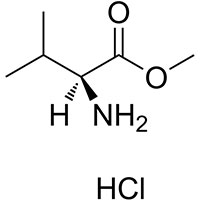L-Valine methyl ester hydrochloride
Nanjing Finechem Holdings Co., LTD
Synonyms
Methyl L-valinate hydrochloride (1:1)
Methyl-L-valinathydrochlorid
methyl (2S)-2-amino-3-methylbutanoate hydrochloride
MFCD00012497
L-valine methyl ester hydrochloride
L-Valine, methyl ester, hydrochloride (1:1)
EINECS 228-620-9
methyl (2S)-2-amino-3-methylbutanoate,hydrochloride
H-Val-OMe·HCl
H-Val-OmeHCl
Product Description
Introduction:
L-Valine Methyl Ester Hydrochloride is a chemical compound belonging to the family of amino acids. It is
a derivative of L-valine, an essential amino acid that plays a crucial role in protein synthesis and
various metabolic processes. This product is widely utilized in the pharmaceutical, food, and cosmetic
industries due to its unique properties and potential applications.
Raw Materials:
L-Valine Methyl Ester Hydrochloride is synthesized using high-quality raw materials, including L-valine
and methyl ester hydrochloride. L-valine is typically derived from natural sources or produced through
fermentation processes, ensuring its purity and effectiveness. Methyl ester hydrochloride is obtained
through appropriate chemical reactions and subsequent purification steps, ensuring the desired quality
of the final product.
Production Process:
The production of L-Valine Methyl Ester Hydrochloride involves a series of carefully controlled steps to
ensure consistent product quality. The synthesis begins with the extraction or synthesis of L-valine,
which is then reacted with methyl ester hydrochloride under specific conditions. The reaction mixture
undergoes purification techniques such as filtration, crystallization, and drying, resulting in a white
crystalline powder as the final product.
Market Trends:
L-Valine Methyl Ester Hydrochloride has experienced growing demand in recent years due to its potential
applications in various industries. In the pharmaceutical sector, it is widely used as a building block
in the synthesis of new drug compounds and as a supplement in nutritional formulations. The increasing
interest in natural and functional ingredients has also driven the demand for L-Valine Methyl Ester
Hydrochloride in the food and beverage industry. Furthermore, its incorporation in cosmetic products is
fueled by its potential benefits for skin health and rejuvenation.
Amino Acid Status:
As an amino acid derivative, L-Valine Methyl Ester Hydrochloride offers unique advantages over
traditional amino acids. Its chemical structure and properties make it highly bioavailable and easily
absorbed by the human body. Additionally, L-valine, the precursor of this compound, is an essential
amino acid that cannot be synthesized by the body, underscoring the importance of its dietary intake.
The availability of L-Valine Methyl Ester Hydrochloride as a supplement provides a convenient and
effective means to ensure optimal L-valine levels in the body.
Conclusion:
L-Valine Methyl Ester Hydrochloride is a versatile chemical compound with diverse applications in the
pharmaceutical, food, and cosmetic industries. Its synthesis from high-quality raw materials and
stringent production processes guarantee consistent product quality. The market demand for this product
is expected to continue growing due to its unique properties and potential benefits. With its high
bioavailability and essential amino acid status, L-Valine Methyl Ester Hydrochloride offers a valuable
option for various formulations and applications, catering to the needs of different industries.





